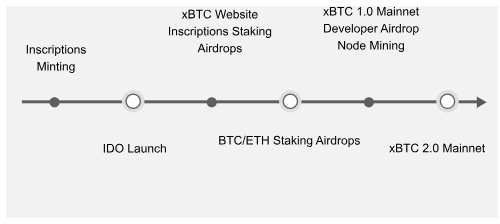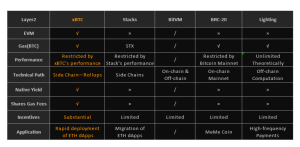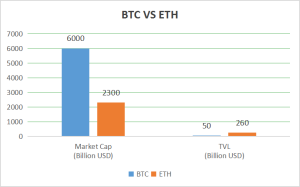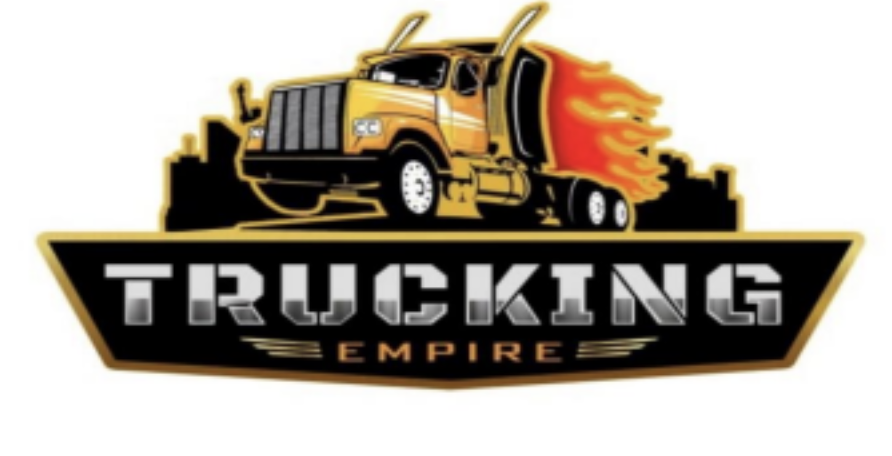As Ordi’s price breaks the $70 barrier, marking a staggering 20,000% rise in just nine months, it triggers an inscriptions frenzy in the crypto world. This surge propels BTC’s ecosystem into the limelight, making it a focal point in the crypto industry.
With the growing Fomo around BTC inscriptions, challenges like high transaction fees and slow settlements in the BTC network are becoming more evident. Crypto narratives often revolve in cycles, and years ago, discussions on BTC’s performance led to various expansion proposals.
Ideas like increasing block space, sidechains, and lightning networks have simmered under the surface. However, the current demand for inscriptions transactions rekindles the market’s desire for BTC expansion, with Layer2 solutions emerging as potential focal points of the narrative.
Among them, BTC Layer2 solutions are gaining focus. Current market Layer2 face challenges like limited TVL, lack of EVM compatibility, and complexity in use. Stack is suffering from low TVL and complexity due to its non-EVM compatibility. BEVM and RGB are yet to be launched. With BTC’s halving approaching, a fierce competition among Layer2 is imminent.
This article delves deep into the BTC Layer2 ecosystem, spotlighting a new competitive project: xBTC. Before delving into xBTC, it’s crucial to understand the significance of Layer2 solutions in the BTC ecosystem.
Why is Layer2 Crucial for Bitcoin?
Layer2 solutions are increasingly vital for Bitcoin, primarily due to:
- Expanding Transaction Volume: With BTC inscriptions on the rise, the Bitcoin network struggles to keep up. As of now, it faces a backlog of over 504,182 unconfirmed transactions, processing merely seven transactions per second. This bottleneck hampers the ecosystem’s growth, emphasizing the need for Layer2.
- Sustainability of Mining Rewards: The BTC community faces a potential mining crisis. While inscriptions have boosted miner revenue, the network’s capacity and speed limits hinder transaction activities. Incorporating Layer2 solutions with more use cases and fees could significantly enhance miner profitability and sustain mining power growth.
- Block Expansion Constraints: Given the complexity of expanding BTC blocks, the community favors building new layer2 on top of the existing BTC Layer1. This approach solves congestion issues while maintaining compatibility and not disrupting the primary system. The consensus leans towards developing Layer2 solutions like lightning networks and sidechains.
- Breaking the Simple Ledger Limitation: EVM-compatible Layer2 allow seamless construction of various dApps, such as DEXs, lending platforms, and stablecoins within the BTC ecosystem.
Unveiling xBTC
Currently, there’s limited information on xBTC. From what is known, xBTC is a BTC Layer2 platform compatible with EVM, aiming to unleash Bitcoin’s full potential and provide an efficient, scalable environment for users and developers. It introduces unique incentives like minting inscriptions, IDO, and Blast staking invitations. Users can earn tokens by participating in minting Inscriptions and IDO activities and through airdrops.
Furthermore, xBTC plans to airdrop tokens to developers, with later phases distributing BTC gas earnings to developers and node miners. This strategy aims to invigorate the community and encourage contributions from developers.
xBTC strives to advance BTC technology, aiming for making bitcoin great again and widespread application of decentralized finance within its ecosystem. Its vision is to create an open, inclusive, and efficient BTC ecosystem, benefiting and growing with every participant.
EVM Compatibility: Lowering the Barrier for Developers
In the fast-paced blockchain technology landscape, Layer2 solutions help extend applications and scenarios beyond the capabilities of Layer1 like BTC. For Layer2 platforms, choosing a developer-friendly language and minimizing entry barriers are crucial. The complexity of a Layer2’s design and high entry barriers can limit its expansion potential.
Most smart contract developers in the crypto field have grown within the EVM ecosystem. With over 80% of the world’s 400,000 smart contract developers specializing in EVM, EVM compatibility is not just a technical choice but a strategic move for Layer2 platforms to flourish.
For BTC Layer2, EVM compatibility means quickly attracting developers and users, focusing on practical application rather than purely on native technological advancement. xBTC, built on this philosophy, fully embraces EVM compatibility, significantly reducing technical development barriers and leveraging Bitcoin’s strong computing power and security. This allows for a seamless transition of various applications from the EVM ecosystem, like DeFi and GameFi, into BTC’s Layer2 network.
Layer2 Innovations: Sparking Creativity Among Users and Developers
xBTC introduces innovative gameplay strategies in the BTC Layer2 ecosystem, crucial for attracting users and developers, especially in its nascent stages.

To engage users, xBTC has introduced diversified participation methods. Users can become early project participants through minting Inscriptions and participating in IDO. These strategies aim to reward early contributors and elevate the ecosystem’s overall activity and participation.
Incentives for Users
- Inscriptions Minting & IDO Launch
To attract more users, xBTC offers various participation methods. Users can become early project participants by minting inscriptions and participating in IDO. This strategy aims to reward early contributions and increase ecosystem engagement.
- Inscriptions Staking Airdrops
Drawing from Blast’s successful airdrop experience, xBTC will soon launch an inscriptions staking airdrop initiative. Users can earn points by staking inscriptions and inviting new members, gaining access to super spin and lucky cards and additional points. These points will be transferred for tokens once the xBTC 1.0 mainnet launches, further incentivizing community involvement.
- BTC/ETH Staking Airdrops
Following the conclusion of the inscriptions activities, xBTC plans to initiate BTC and ETH staking airdrops. This initiative is designed to further boost user engagement and infuse additional liquidity into the ecosystem, invigorating the growth of the BTC Layer2 environment.
- Node Mining
Upon the launch of the xBTC 1.0 mainnet, its EVM compatibility will attract a host of developers from the existing Ethereum ecosystem to build dApps on the xBTC chain. This development will generate substantial BTC gas. xBTC will introduce node mining activities, allowing anyone to apply as a node and share in the BTC gas revenue.
Developer Incentives
- Developer Airdrop Activities
Following the launch of the xBTC 1.0 mainnet with EVM compatibility, xBTC will initiate a developer airdrop campaign to encourage more developers to build dApps on its chain.
The current number of developers in the BTC ecosystem is significantly lower than in other major crypto ecosystems, making the attraction of additional developers a pressing necessity. Sufficient developer engagement is crucial for building a comprehensive product architecture and propelling the ecosystem’s momentum.
- Distribution of BTC Gas to Developers
In the future, once xBTC 1.0 mainnet is live, BTC will serve as the native gas on the mainnet, and the gas fees generated will be distributed to developers who build dApps on the xBTC chain.
With this comprehensive set of incentives, xBTC aims to energize the entire ecosystem, propelling the development of BTC Layer2 technology and realizing a richer, more efficient BTC ecosystem. This initiative is not only an opportunity for a win-win situation for investors and developers but also a significant contribution to the broader field of cryptocurrency.
Comparing Major BTC Layer2 Solutions
Research indicates that a successful BTC Layer2 solution should adhere to several key design principles:
- EVM Compatibility: The complexity of a Layer2’s design and the high entry barriers can hinder its effectiveness. A successful BTC Layer2 solution must offer EVM compatibility to facilitate easy adoption by developers and users.
- Community Consensus and Support: The success of a BTC Layer2 platform hinges on whether it can gain the consensus and support of the main Layer1 network users. Using BTC as gas is crucial in securing the support and consensus of the BTC community.
- Developer Incentive : The ability to attract developers to build dApps on the platform is a critical aspect of a successful BTC Layer2 solution. Incentive mechanisms play a pivotal role in this process.

Conclusion and Prospects
The emergence of xBTC in the BTC Layer2 domain represents a significant new force. Compared to the bustling ecosystem of Ethereum and other cryptocurrencies, the number of projects in the BTC ecosystem is relatively small, but its market capitalization is substantial. While the total value locked (TVL) in the Ethereum ecosystem is approximately $260 billion, the TVL in the BTC ecosystem is around $50 billion. Given BTC’s nearly $600 billion market capitalization compared to Ethereum’s approximately $230 billion, there is significant growth potential in the BTC Layer2 space.

xBTC brings EVM compatibility and lowered development barriers to the BTC ecosystem, coupled with its unique innovative gameplay, attracting active participation from users and developers. These contributions not only infuse new vitality into the existing BTC community but also lay a solid foundation for the future growth and prosperity of the BTC ecosystem.
The official launch of xBTC’s inscriptions minting and IDO is imminent. With these innovative measures, xBTC is poised to become a key player in the BTC Layer2 field in the near future.
Let us look forward to and witness how this journey unfolds, embarking on this fair and innovative journey in the BTC Layer2 space together!
For more information about xBTC, please visit the official website and social media platforms.
Official Website: https://xbtc.finance
Join the Official Community











